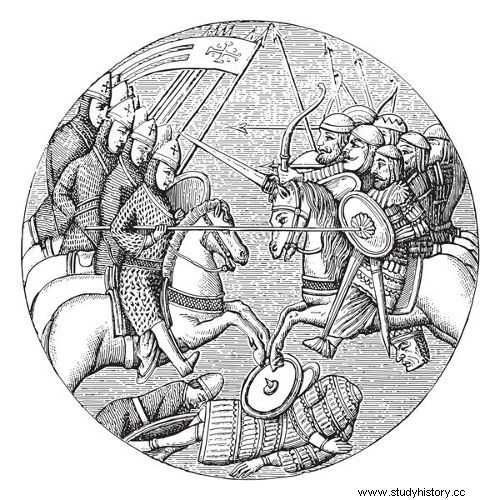
Christianity established itself as an institution in the final centuries of the Roman Empire. As the Roman Empire crumbled into internal crises, the Catholic Church strengthened and established its foundations. The persecution of Christians ended in 313 with the Edict of Milan, signed by Emperor Constantine. From 380, with the signing of the Edict of Thessalonica by the emperor Theodosius , Christianity became the religion official of the Empire.
The establishment of the Church and the formation of ecclesiastical doctrine took place through the conflicts caused by the heresies , that is, all religious doctrines that were not in accordance with prevailing orthodoxy. These heresies put the Church's existence at risk and were harshly fought. As examples, we can cite Gnosticism , Pelagianism , priscilianism and Arianism , one of the heresies that had the most adherents.
Arianism arose through the doctrine of Arius (lived in the 4th century) and denied the concept of the Trinity . For Arius, the Father and Christ did not share the same substance, so Christ was not God. He considered Christ a creation of the Father and, though divine, was inferior to the Father. Arianism conquered numerous adherents throughout the Christian world, even being defended by emperors, as was the case of Constantius II.
The problem of Arianism was so great that it was spread over the Germanic peoples from Úlfilas, who converted the Goths, spreading to Ostrogoths , Visigoths , vandals etc. The Catholic Church established itself among the Germanic peoples from the conversion of Clóvis , King of the Franks in the 6th century.
This first moment of establishment of the Church owed much to some personalities, such as Saint Augustine, Saint Athanasius, Saint Jerome, Gregory the Great etc. All contributed to the construction of ecclesiastical doctrine and the strengthening of the Church from the fight against heresies.
Departure from Byzantium and the rise of Islam

Battle of Ascalon, 1099, during the First Crusade
After the evangelization of the Germanic peoples, Christianity faced a new threat to its hegemony with the emergence of Islam and its fulminant expansion from the concept of holy war, the jihad . Thus, Islam spread throughout North Africa and, from 711, conquered almost the entire Iberian Peninsula. The Muslim expansion in Europe was only stopped in 732, at the Battle of Poitiers, which prevented Muslims from entering the Kingdom of the Franks.
In addition to Islam, the Church also faced the separation between Christianity based in Rome and Christianity based in Constantinople. Theological differences between the Latin Church and the Byzantine Church resulted in the Great Eastern Schism in 1054. The Great Schism was the definitive separation of the Church based in Rome from the Church based in Constantinople. Thus, the Orthodox Apostolic Catholic Church was born.
Crusades
From 1095, after the summons of Pope Urban II, the Catholic Church started a military movement called the Crusades (according to Le Goff, the name “Crusades” only appeared in the 15th century|1| ) to conquer Jerusalem, the Holy Sepulcher and any other site in Palestine considered sacred from Muslim control.
Furthermore, the Church saw the Crusades and the establishment of a common enemy as a way to channel the growing violence manifested by the European nobility. To justify the Crusades, the concept of Just War, was developed which asserted that war was acceptable if it was waged against the pagan – in this case, the Muslim.
In all, eight crusades were carried out over more than a hundred years. The first Crusade it was marked by the violence of the conquest of the city of Jerusalem in 1099. From then on, a brief Christian kingdom was established in Palestine. The city of Jerusalem was reconquered by the Muslims in 1187. The Fourth Crusade marked the sack of Constantinople by the Christians in 1204.
The last Crusades were led by St. Louis and resulted in great failure. The last Christian domains in Palestine, Acre and Tyre, were reconquered by the Muslims in 1291. The Crusades contributed to increasing the distance between Christians and Muslims.
Inquisition
From the twelfth century, heresies gained new strength in Christian circles, and the Church began to fight them harshly. The heretical movements of this period were characterized by the great popular appeal they had. As heresy was considered the greatest of all sins, the Court of the Holy Inquisition was created. Two great heretical movements of this period stood out:the Albigensians and the Waldenses .
The function of the Inquisition was to investigate, judge and condemn all those involved in heretical movements. For this, the use of torture was permitted by the Church, and the guilty were condemned to the stake. Historians are not sure how many were killed by the Tribunal of the Holy Inquisition, but it is estimated that thousands of people were killed.
|1| LE GOFF, Jacques. The medieval roots of Europe. Petrópolis:Vozes, 2011, p.135.
